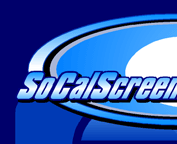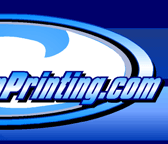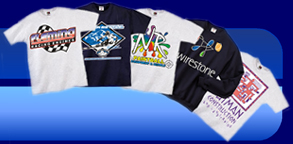|
| GENERAL INFORMATION: Garment
screen printing is a mass-production-manufacturing method by
which, most typically, a quantity of finished garments is
printed with a design, in one or more of several kinds of ink.
A permeable
printing fabric is stretched tightly across a frame. To this
fabric, typically by mechanical and photographic means (similar to
those used in basic black-and-white photography), a stencil is
affixed. This screen/stencil represents one color in a multi-color
design. For every color in the design, another stencil, another
screen, and another position on your printing press are required.
In other words, if you're printing a design composed of four
colors, you'll require a four-color press with four screens, each
of which bears its own stencil.
Each with a
separate squeegee, the ink colors are, in turn, pushed through
their stencils onto the garment. This is done by hand on a manual
press, or mechanically on an automatic press.
After all the
colors have been printed on the garment, it is typically run
through a conveyorized dryer, or curing unit, which cures the ink,
to make the design impervious to normal washing and drying as well
as normal wear and tear.
The decorated
garments are then sold at retail, at wholesale, by mail order or
through any number of different outlets, and you can pocket the
profit. Don't be fooled, though. You can loose money almost as
easily as you can make it if proper understanding and appropriate
planning aren't part of your formula for success.
The above, of
course, is a very simplified description of the
garment-screen-printing process. It gets more complex from here.
Still, if it sounds appealing, read on, always bearing in mind
that the best way to establish a successful garment-decorating
operation is to learn as much as you can about the market and the
procedures involved in serving it, prior to making any significant
investment in equipment or supplies, and prior to making any
long-range business plans.
There are various types of
apparel decorators in this industry. The three most common are the
custom decorator, who prints or embroiders for clientele of all
kinds, providing not only the decorating and, in many cases,
graphic-design services, but also the garments themselves. The
diversity of this type of printing requires a diverse technical
knowledge.
Then there is the
in-house or pre-print decorator who develops, maintains, decorates
and markets an exclusive line of designs to be sold at retail,
through mail order or otherwise. This type of printer typically
places greatest emphasis in the art and marketing departments.
These shops also require a sales force-either sub-contractors or
salaried/commissioned sales people.
Finally is the
contract decorator who typically does nothing but screen printing,
usually in large volumes, utilizing both designs and garments
provided by accounts that include retailers, sports- and
entertainment-license holders, other garment decorators,
manufacturers and the like. This type of printer is typically
automated, as the large volume of garments and often intricate
customer-supplied designs are too labor intensive to be printed
manually.
There are a few
other, very specialized niches that don't fall strictly into the
above classifications. There are also various combinations of the
above three. But in most shops, the majority of work performed
falls into either custom, pre-print or contract categories. It is
important, therefore, in terms of establishing your new business,
to determine what kind of work you intend to pursue. |
|
|
Artwork |
 Top Top |
Though
there are many ways to create art, the artist should know some
basic information for creating art for screen printing. Some of
the questions the artist should ask include:
- What is the
substrate? (color? type of garment? material content?)
- What type of
print? (process? spot?)
- What size does
the art need to be? (child? adult? left-chest?)
- What are the
ink opacity requirements? (bright? muted? glossy? matte?)
- Is an underlay
needed? (bright ink on darks? specialty inks?)
- What are the
registration requirements? (butt? trap? overprint?)
- What are your
production capabilities? (auto? manual? number of colors?)
Though most
information can be standardized for each shop, some will be
influenced by the customer's vision of what he or she wants to
achieve with the print.
|
| Art
Creation |
 Top Top |
| The three most common forms of
art created for screen printing are hand-drawn art,
computer-generated art, or art replicated from fine paintings or
photographs. |
| Hand-Drawn
Art |
 Top Top |
| Hand-drawn art comes in many
forms. An artist can create a keyline (an outline of the design)
by drawing it on paper with an opaquing pen, shooting it on a
camera, or scanning it into a computer. Art can be created from
a hand-drawn keyline provided the image is loaded into a
scanning program, converted into paths, and then placed into an
art program. With the image in a format that can be manipulated,
the artist can clean it up, change its size and position, add
text, and place color in selected areas. Another option is to
draw directly onto vellum or onto a coated screen. This method
is not recommended, but it is effective for simple one-color
designs. |
| Computer-Generated
Art |
 Top Top |
| Computer-generated art is
conceived and designed on a computer through a variety of design
programs. The most common programs in the screen-printing
industry are PhotoShop, Illustrator, Freehand, and Corel.
Designs created on a computer are then separated with the
computer's separation program. |
| Replications |
 Top Top |
| Replications of fine art or
photographs are most successful when they are shot with a
digital camera or scanned into a computer. The artist can then
utilize an advanced color separator program on the computer. The
artist also can separate replications by hand through a series
of hand-cut overlays. |
| Art
Separations |
 Top Top |
| After creation, art must be
converted into final separations. The goal of art separation is
to create individual films, either acetate or vellum, in which
the print areas block UV light rays and the negative areas allow
UV light to pass through. The most frequently used methods
involve separating by hand, camera, and computer. |
| Hand
Separations |
 Top Top |
| An
artist can achieve hand separations in several ways.
Hand-cut
positives are created by cutting photomasking film, or rubylith,
into the shapes or letters needed. Then the artist peels away
the negative unwanted portion, leaving rubylith in the areas to
be printed.
Overlays are
color separations created by the use of acetate or rubylith
overlaid on a keyline to create positives. By cutting, drawing,
applying adhesive dot patterns, and using acetate or burnishing
letters, the artist can build each color (as well as additional
colors with dot pattern overlays).
Hand-drawn
separations are created by tracing the design directly onto the
acetate or vellum. Starting with a keyline of the design, the
artist overlays each color one at a time and traces until all of
the separations are completed.
|
| Camera
Separations |
 Top Top |
| Camera
separations are created by the use of a camera or other exposing
equipment, such as a contact frame, to create acetate positives.
An artist may use the camera to shoot separations from a laser
jet printer or a hand-drawn keyline, as mentioned earlier. An
acetate keyline from the camera then could be used as the basis
for the hand-cut separation, utilizing rubylith (as mentioned
earlier) to achieve the trap method of printing. The trap method
is simply when colors slightly overlap where they meet on a
design. Using basically the same method, instead of peeling off
the negative areas after cutting the rubylith, the artist peels
off the positive areas, leaving the print areas clear. The
artist then takes this overlay (still attached to the keyline),
and exposes it to reversal film on the contact frame. The end
result is a perfect butt registration (or perfect dropout) of
the separated color.
An artist also
can utilize the camera to create "user-friendly"
separations for the production department. Choking a color means
that the artist produces a slightly smaller color separation, as
if there is a hairline space between the separation and its
adjacent color. Choking allows easier registration of overlay
colors (if the choked color is a white underlay) and helps stop
colors from bleeding into each other by creating a slight
barrier of fabric. To choke a color, simply place acetate sheets
between the art and the film. The light will naturally expose
inside the edges, creating a slightly smaller image on the film.
To create a white underlay, an artist can register the film
separations together on a contact frame and expose them onto
duplicate film. This method automatically chokes the plate. This
method is also useful in creating transfers because it is
critical to butt-register all transfer colors.
|
| Computer
Separations |
 Top Top |
| Computer
separations usually are rendered from art created in a computer
graphics program. Other art can be separated with the use of a
computer, but first it must be scanned or converted digitally
before it can be manipulated in a graphics program. Although
there are many separation programs and drawing programs with
separation options, they all must reach a common end.
A piece of art
created in a vector program is separated easily because the
color usage is controlled during the creation of the art. The
program will render separations per color and will print out
exactly what the artist needs.
Fine art or
photographs can be separated by computer provided the artist has
access to a large-format scanner, a drum scanner, or a digital
camera. (If the art department doesn't own any equipment, a
service bureau can be paid to scan these images.) For best
results, the image should be scanned at about 300 DPI in an RGB
mode and saved as a TIFF file. Once the piece of art is
converted digitally, it can then be introduced into the design
program (in this case, preferably a program that can manipulate
full-color scanned images, like PhotoShop). When a design is in
this type of program, it can render process separations, or
areas of color can be selected to create individual channels for
each color, producing spot plates. The use of PhotoShop plug-ins
can decrease time spent creating spot-color channels. Many of
these plug-ins use a predetermined ink color set, which enables
the finished product to closely resemble the original design.
To calculate line
counts for halftone screens, simply divide the mesh count by
four. The result will equal the highest line count that should
be used. The artist must have an understanding of mesh counts
and their effect on the press. For instance, when a fade is
needed in a design, the artist may be tempted to put it in a
high mesh. However, if that same color also consists of large,
open print areas, the printer will require a mesh in a lower
count. In this instance, the artist should calculate the
halftone line based on the lower mesh. To determine the best
resolution for a design, multiply line count by 2.5. Example: 55
lines = 137.5 resolution. This should prevent the program from
producing undersized dots in the lower-percentage halftone
areas.
When the design
is ready to be separated, it may be printed directly from the
program, or you may split the channels to create individual
files to be printed later. The program creates individual files
for each color, giving the artist the option to go back and
change a color individually if the print performance is not
satisfactory. It is important to label each color and to make
sure that each piece of film is complete with registration
marks. Most programs offer these options on the separation
screen, but some programs require the artist to incorporate the
color names and registration marks with his or her designs. The
artist must type each color name in its own color and color the
registration marks with the "registration" color
option.
Image output
refers to the method in which a computer prints art or
separations. One way of printing separations is on a laser jet
printer. An artist may choose to print out directly on vellum,
which exposes well, or on paper, which is then shot by a camera
to render the films. In addition to laser jet printers, an image
setter may be used to output separations. This equipment enables
the artist to print out his or her art directly onto film (and
can totally replace a darkroom).
It is a good idea
to have a color "mock-up" of the design to accompany
the separations to production. This ensures that everyone from
the screen room through packing are on the same page.
Artists must
understand the limits and advantages of screen printing. They
must react to the needs of the customer as well as those of the
production department. The bottom line is achieving
communication between the departments to ensure a predictable,
repeatable product.
|
|


















